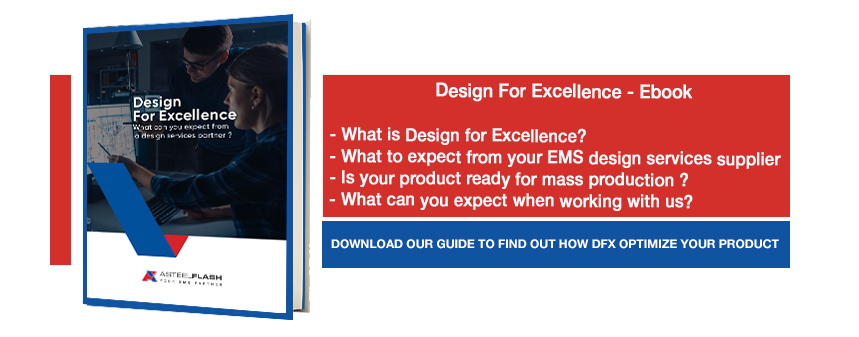Working with an EMS company is an important step in realizing your product goals. But your project’s success is built on more than just finding someone capable of doing the job — it also means finding an EMS partner with a client service philosophy that puts you first, and becomes more than just a service provider.
At Asteelflash, we’ve dedicated ourselves to supporting our clients, no matter where in the world they are. We aim to help them achieve their product design and manufacture goals as active partners.
Here’s what you can expect when working with Asteelflash in the designing phase of your electronics or PCBA manufacturing project:
What can you expect from Asteelflash?
When we start working together, you’ll be assigned a dedicated project manager. This is your main point of contact with the company. They’re responsible for communicating regularly on your project.
First, they’ll work with you to draw up a plan and list of requirements. Then, they will organize weekly status updates with you and key members from the Asteelflash team working on your project. This is how you’ll be fully informed of any identified challenges during the design and production process. You’ll be an active partner in the process to ensure the end result exceeds your expectations.
What are the 4 steps in the design process?
The Asteelflash design service process was created to ensure your product is engineered with minimal wastage and zero failures. When you sign up, our team will work with you through the 4 following stages:
- Specifications : this is a feasibility study. We’ll review your requirements, technical specifications, and conduct a risk analysis.
- Development : this includes two processes: Proof of concept, and the Engineering Verification Test (EVT).
- Industrialization : this entails hard tooling and Developer Verification Tests (DVT).
- Production : here we perform a Product Verification Test (PVT) and send your product to mass production.
You can learn about this in more detail in our blog post on what to expect from your EMS design service.
What is the project lifecycle?
Once the requirements list is drawn up, you can expect the following average timeline from design phase to completion:
- 8–10 months for the design phase;
- 4–6 months for industrialization;
- 2–4 months for the first round of mass production.
Why Asteelflash uses Design for Excellence ?
Asteelflash has perfected working with Design for Excellence (DfX) for over 20 years. Our qualified team of engineers and technicians are trained to bring this methodology to every step of the product design process.
Design for Excellence methods ensure product optimization by systematically improving product cost, quality and time to market through a series of checks and balances that are built into each stage of design and production. It’s an essential part of how we ensure excellent client service, every step of the way.
For more on what Design for Excellence means for PCBA and electronic manufacturing services, visit our essential guide.
Keeping you at the leading edge of your industry
Staying up to date on market knowledge, quality control procedures, and the latest in optimization methods (like Design for Excellence) are a part of our daily routine. That, combined with our client-first philosophy, is what drives our expert team when designing and manufacturing your product from concept to mass production.
Contact us with any questions, or click the button below to request a quote. Our seventeen plants worldwide are fully staffed and outfitted to service your needs in multiple industries, quality guaranteed.




